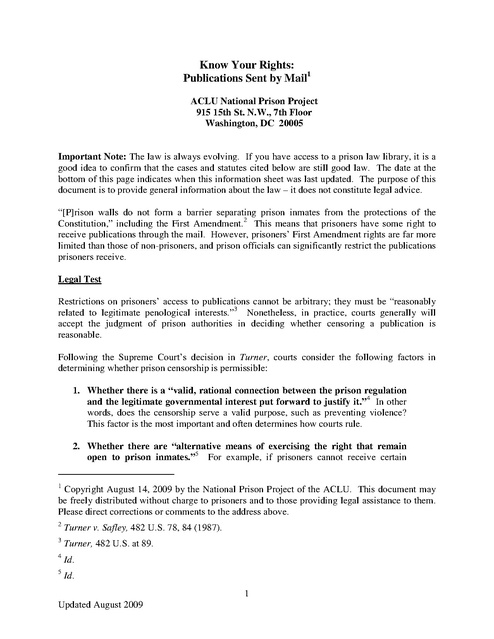Aclu Npp Know Your Rights Publications Sent by Mail 2009
Download original document:

Document text

Document text
This text is machine-read, and may contain errors. Check the original document to verify accuracy.
Know Your Rights: Publications Sent by Mail1 ACLU National Prison Project 915 15th St. N.W., 7th Floor Washington, DC 20005 Important Note: The law is always evolving. If you have access to a prison law library, it is a good idea to confirm that the cases and statutes cited below are still good law. The date at the bottom of this page indicates when this information sheet was last updated. The purpose of this document is to provide general information about the law – it does not constitute legal advice. “[P]rison walls do not form a barrier separating prison inmates from the protections of the Constitution,” including the First Amendment.2 This means that prisoners have some right to receive publications through the mail. However, prisoners’ First Amendment rights are far more limited than those of non-prisoners, and prison officials can significantly restrict the publications prisoners receive. Legal Test Restrictions on prisoners’ access to publications cannot be arbitrary; they must be “reasonably related to legitimate penological interests.”3 Nonetheless, in practice, courts generally will accept the judgment of prison authorities in deciding whether censoring a publication is reasonable. Following the Supreme Court’s decision in Turner, courts consider the following factors in determining whether prison censorship is permissible: 1. Whether there is a “valid, rational connection between the prison regulation and the legitimate governmental interest put forward to justify it.”4 In other words, does the censorship serve a valid purpose, such as preventing violence? This factor is the most important and often determines how courts rule. 2. Whether there are “alternative means of exercising the right that remain open to prison inmates.”5 For example, if prisoners cannot receive certain 1 Copyright August 14, 2009 by the National Prison Project of the ACLU. This document may be freely distributed without charge to prisoners and to those providing legal assistance to them. Please direct corrections or comments to the address above. 2 Turner v. Safley, 482 U.S. 78, 84 (1987). 3 Turner, 482 U.S. at 89. 4 Id. 5 Id. 1 Updated August 2009 publications in the mail, do they have other access to publications? For example, can prisoners still receive other publications in the mail, or read books in a library? 3. What impact the “accommodation of the asserted constitutional right” will have on “guards and other inmates, and on the allocation of prison resources generally.”6 In other words, what are the downsides (including financial cost to the prison system) of not censoring publications? 4. Whether there are “ready alternatives” for furthering the governmental interest.7 In other words, is there something obvious the prison could do that would protect whatever interest the prison has in mind (such as security) without banning publications? The Turner standard applies to convicted prisoners, and somewhat greater protections may apply to pre-trial detainees held in jails.8 The law is unsettled as to the protections afforded to immigration detainees. Some courts have held that immigration detainees are entitled to greater protections than pretrial detainees. Even if a policy is facially constitutional (meaning the policy itself does not violate the Constitution) you may be able to argue that the policy as applied to the particular material you want to receive violates the Constitution.9 Total Ban on Receipt of Publications Many courts have held that the “prohibition of virtually all reading materials deprives the inmates of their First Amendment right to receive information and ideas.”10 However, categorical bans on publications sent by mail have been upheld in some cases, particularly where 6 Id. at 90. 7 Id. 8 Bell v. Wolfish, 441 U.S. 520, 545 (1979) (“[P]retrial detainees, who have not been convicted of any crimes, retain at least those constitutional rights that we have held are enjoyed by convicted prisoners.”). 9 See, e.g., Thornburgh v. Abbott, 490 U.S. 401, 404 (1989) (rejecting facial challenge to Bureau of Prisons policy on incoming publications but leaving open the possibility that the policy might be unconstitutional as applied to particular publications). 10 Parnell v. Waldrep, 511 F. Supp. 764, 768 (W.D.N.C. 1981); see also Mann v. Smith, 796 F.2d 79, 82 (5th Cir. 1986) (striking down jail’s categorical ban on magazines and newspapers); Payne v. Whitmore, 325 F.Supp. 1191, 1193 (N.D. Cal. 1971) (striking down jail’s total prohibition on receiving newspapers and magazines by mail). 2 Updated August 2009 such rules apply to jails that hold detainees for a short period of time or prisoners in particularly restrictive segregation units.11 News and Political Speech Courts have generally struck down rules which deny inmates access to mainstream newspapers and magazines.12 The confiscation of inmates’ political literature violates the First Amendment unless prison officials can show that the publication poses a danger to prison security—for example, by inciting violence.13 Weapons, Escape Plans, and Illegal Activity Prisons and jails may ban material that describes how to build weapons, instructs how to escape, or instructs how to break the law.14 Nudity and Pornography Courts have held that prisons and jails generally can ban magazines that contain frontal nudity and/or pornography (including magazines such as Playboy and Penthouse, as well as more “hardcore” magazines).15 Courts are divided as to whether magazines that show partial nudity (such as Stuff and FHM) can also be banned.16 It has also been held that prohibitions on nudity 11 E.g. Beard v. Banks, 548 U.S. 521, 531 (2006) (prison may ban inmates in long-term segregation unit from receiving newspapers and magazines); Hause v. Vaught, 993 F.2d 1079, 1084 (4th Cir. 1993) (jail holding detainees for short periods of time may ban prisoners from receiving publications in the mail). But see Parnell, 511 F. Supp. at 768 (striking down publications ban at jail); Mann, 796 F.2d at 82 (same); Payne v. Whitmore, 325 F. Supp. at 1193 (N.D. Cal. 1971) (same); Prison Legal News v. Fulton County, 1:07-CV-2618-CAP (N.D. Ga. July 13, 2009) (same). 12 E.g. Morrison v. Hall, 261 F.3d 896, 903-05 (9th Cir. 2001) (striking down regulation limiting prisoners to first class and second class mail that prevented prisoners from receiving The New York Times, Sports Illustrated, and Montana Outdoors); Prison Legal News v. Cook, 238 F. 3d 1145, 1151 (9th Cir. 2001) (striking down same regulation as applied to Prison Legal News). 13 E.g., Greybuffalo v. Kingston, 581 F. Supp. 2d 1034 (W.D. Wis. 2007) (prisoner had right to receive literature regarding the American Indian Movement, a civil rights organization, but not literature from a Native American group characterized as a “gang”). 14 E.g., Thornburgh v. Abbott, 490 U.S. 401, 405 n. 5 (1989). 15 Mauro v. Arpaio, 188 F.3d 1054, 1063 (9th Cir. 1999) (en banc); Amatel v. Reno, 156 F.3d 192 (D.C. Cir. 1998). 16 Compare Strope v. Collins, 492 F.Supp.2d 1289, 1300 (D. Kan. 2007) (denying summary judgment to prison officials who refused to deliver FHM and stating “a rational trier of fact could conclude that defendants’ censorship of entire publications based on the fact that they contain a few photographs of women which reveal their partially bare buttocks is not reasonably related to a legitimate penological interest”) with Moses v. Dennehy, 523 F.Supp.2d 57, 64 (D. Mass. 2007) 3 Updated August 2009 that lack exceptions for materials with artistic merit (such as pictures of nude figures on the Sistine Chapel ceiling) are not constitutional.17 Bureau of Prisons Program Statement 5266.10 – which applies to federal prisons only – lists the following examples of publications that contain some nudity but nonetheless may be delivered to prisoners: National Geographic; Our Body, Our Selves; sports magazine swimsuit issues; and lingerie catalogs. Religious Publications Under the First Amendment, the Turner standard, described above, also applies to religious exercise.18 Thus, regulation of publications will overcome First Amendment challenges if the restrictions are reasonably related to penological interests. However, prisons cannot discriminate against religious publications by arbitrarily subjecting them to rules that do not apply to nonreligious publications.19 In addition to the First Amendment, access to religious publications is sometimes protected by the Religious Land Use and Institutionalized Persons Act, 42 U.S.C. § 2000cc et seq. (RLUIPA) (which applies to non-federal prisoners) and the Religious Freedom Restoration Act, 42 U.S.C. § 2000bb et seq. (RFRA) (which applies to federal prisoners). Generally speaking, RLUIPA and RFRA are more protective of religious exercise than the First Amendment, prohibiting state or local institutions from imposing a substantial burden on the religious exercise of prisoners unless that burden furthers a compelling government interest and is the least restrictive means of furthering that interest.20 For example, some courts have held that prisons may not ban even religious materials that express racist or intolerant thoughts, so long as they do not advocate actual violence.21 However, courts have held that prison officials do not violate RLUIPA or the (listing FHM and Stuff along with magazines that show full nudity, describing them collectively as publications that “invariably contain nude or semi-nude depictions, or sexually explicit content,” and upholding ban on such publications). 17 Aiello v. Litscher, 104 F. Supp. 2d 1068, 1080 (W.D. Wis. 2000). 18 See O’Lone v. Shabazz, 482 U.S. 342, 350-53 (1987). 19 Bess v. Alameida, No. 03-2498, 2007 WL 2481682, at *17 (E.D. Cal. Aug. 29, 2007) (rule that “applied solely to religious publications, distinguishing between religious publications and all other publications” violated the Constitution); see also generally Church of the Lukumi Babalu Aye, Inc. v. City of Hialeah, 508 U.S. 520, 532 (1993) (“At a minimum, the protections of the Free Exercise Clause pertain if the law at issue discriminates against some or all religious beliefs.…”). 20 Cutter v. Wilkinson, 544 U.S. 709, 712 (2005). 21 E.g., Nichols v. Nix, 810 F. Supp. 1466 (S.D. Iowa 1993), aff’d, No. 93-1490, 1994 WL 20653 (8th Cir. Jan. 28, 1994). 4 Updated August 2009 First Amendment when they prevent prisoners from receiving racist and intolerant publications that actively advocate violence.22 Publisher Only Rules Court have generally upheld rules that only permit prisoners to receive hardcover and softcover books and bound periodicals from commercial sources.23 However, some courts have held that prisoners cannot be prohibited from receiving clippings and copies of articles from noncommercial sources.24 Gift Subscriptions Most courts have held that prison officials cannot prevent friends or family members from purchasing gift subscriptions for prisoners by forcing prisoners to pay for subscriptions out of their own accounts.25 Other cases have reached the opposite conclusion.26 Right to Notice Prisoners have a right to be notified by prison officials when they censor an incoming publication.27 Practical Considerations • 22 In theory, prisons and jails cannot unreasonably restrict access to publications. Nonetheless, winning a lawsuit that challenges a restriction on publications (even a seemingly unreasonable restriction) is not an easy task. Courts will expect you to be able to prove that a restriction serves no reasonable purpose. This means that even to defeat a policy that seems arbitrary or too restrictive on its face, you Borzych v. Frank, 439 F.3d 388, 390-91 (7th Cir. 2006). 23 Bell v. Wolfish, 441 U.S. 520, 549-550 (1979); see also Ward v. Washtenaw County Sheriff’s Dep’t., 881 F.2d 325, 329 (6th Cir. 1989); Hurd v. Williams, 755 F.2d 306, 308-09 (3d Cir. 1985); Kines v. Day, 754 F.2d 28, 30 (1st Cir. 1985); Cotton v. Lockhart, 620 F.2d 670, 672 (1980). 24 Allen v. Coughlin, 64 F.3d 77, 81 (2d Cir.1995); see also Lindell v. Frank, 377 F.3d 655, 65960 (7th Cir. 2004). 25 Crofton v. Roe, 170 F.3d 957, 961 (9th Cir. 1999); Jacklovich v. Simmons, 392 F.3d 420 (10th Cir. 2004). 26 Wardell v. Maggard, 470 F.3d 954, 961-63 (10th Cir. 2006) (prison policy banning gift subscriptions is constitutional); Rice v. State, 95 P.3d 994, 1011-12 (Kan. 2004). 27 E.g., Procunier v. Martinez, 416 U.S. 396, 417 (1974) (holding that the “decision to censor or withhold delivery of a particular letter must be accompanied by minimum procedural safeguards,” including notice), overruled on other grounds, Thornburgh, 490 U.S. 401; Prison Legal News v. Cook, 238 F.3d 1145, 1152-53 (9th Cir. 2001). 5 Updated August 2009 will probably still need to develop a full factual record about whether the policy is justified. This can be extremely difficult if you do not have the funds to conduct full discovery or afford expert witnesses. 28 • In some cases, you may be able to show that a policy is unreasonable because the prison’s rationale conflicts with other policies. For example, if a prison bans magazines on the ground that they create a fire hazard but allows newspapers and books that create similar fire risks, you may be able to show that the ban on magazines is not rational. • If you are challenging the failure to deliver publications on a limited number of occasions, a court may hold that prison officials did not violate the Constitution by failing to deliver the publications to you even if you had a constitutional right to receive them. This is because isolated failures to deliver publications may be the result of negligence by mailroom personnel, rather than intent to violate the Constitution.28 • If your goal is to obtain a judgment awarding money (as opposed to only changing the rules or allowing you to receive a publication), several additional doctrines may make it very hard (though not always impossible) to succeed in court. • When you learn that a publication has been rejected, you should always try to check the institution’s publication policy. If you believe the policy has been violated, you may be able to get the publication delivered by filing a grievance showing that the failure to deliver the publication violated the policy. E.g., Jones v. Salt Lake County, 503 F.3d 1147, 1163 (10th Cir. 2007). 6 Updated August 2009





